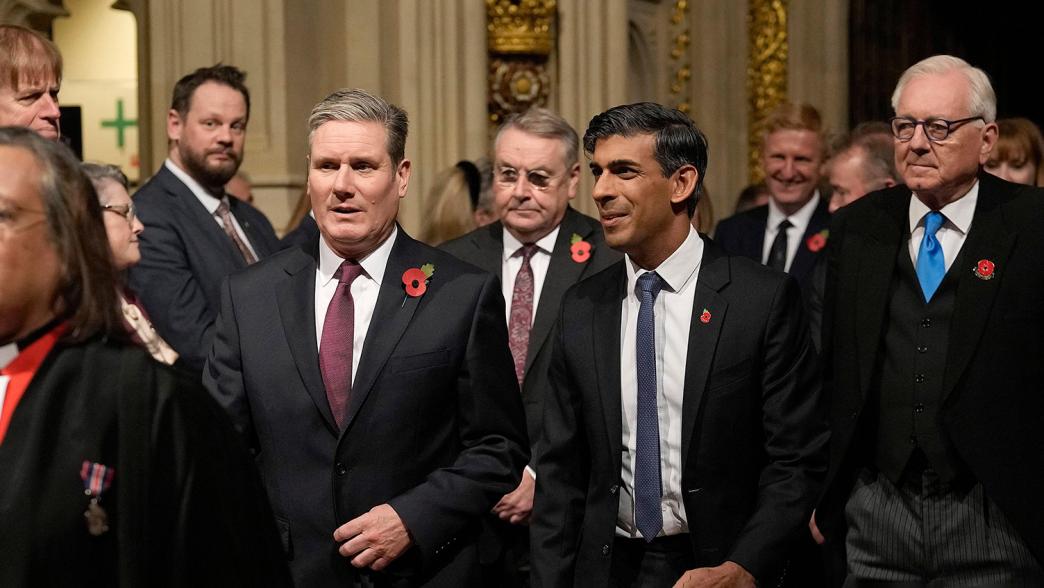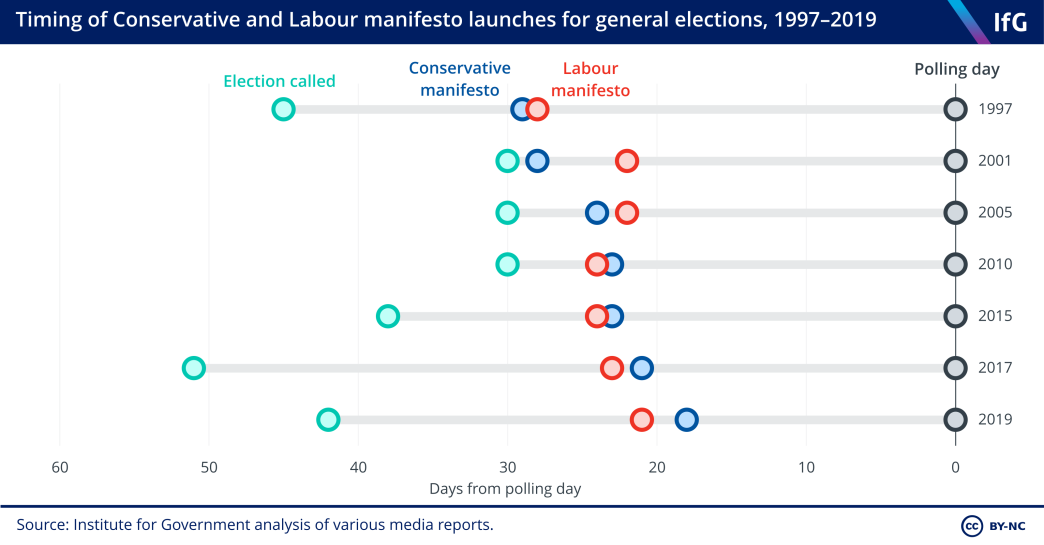What is a manifesto?
Manifestos set out the policies a political party would deliver if they were to win an election.

A political manifesto is a document published by a political party before a general election, setting out the policies they would deliver if they were to win. Manifestos contain a description of the wider narrative a party is attempting to convey to the electorate and the background to its choice of policies.
How are manifestos written?
Each political party prepares their manifesto differently, and the process often changes between elections.
The Labour and Liberal Democrat party constitutions set out formal processes by which manifestos are consulted on and approved by committees of party members. In contrast, the Conservative manifesto development process is less formalised and not outlined in the party’s constitution. The time spent writing a manifesto can vary considerably depending on the election timing, with snap elections, for example, potentially shortening the process.
Ahead of the 2024 general election, Keir Starmer’s team reportedly set a deadline of 8 February 2024 for individual shadow teams to submit policy proposals for the Labour manifesto. 15 Parker G, Pickard J, Fisher L, ‘Starmer sets February 8 deadline to finalise draft Labour manifesto’, Financial Times, 21 January 2024, www.ft.com/content/96f97332-36dd-44e5-8a24-9592965ca4f9 Less is known about the timeline for Rishi Sunak’s team writing the Conservative manifesto, however neither party is likely to release their final manifesto document until after the election has been announced.
Watch our event on what makes a good manifesto
What is the importance of manifestos in an election campaign?
Manifestos are an important electoral tool, used by parties to try and win votes at an election. While some manifesto promises will have little impact on the electorate, headline pledges or slogans can feature heavily in the campaign, shape media narratives and potentially influence how people vote. For example in 2017, backlash against the Conservative party’s policy on social care led Theresa May to change the party’s manifesto commitment.
Manifestos are normally published during the campaign, approximately three weeks before polling day. Manifestos are typically launched at a campaign event covered by the media. The Conservative and Labour parties coordinate to avoid releasing their manifestos on the same day. In 1992 miscommunication led to both parties’ manifestos being launched on 18 March. 16 Major J, John Major: The Autobiography, Harper Collins, 1999 (p299)

How are manifestos costed?
Debates about the credibility of a party’s spending commitments are common in election campaigns. There is currently no government department or public body that independently costs manifestos, but political parties often produce their own costings and think tanks, such as the Institute for Fiscal Studies, independently analyse the costs.
Civil servants will also use the manifesto during the campaign to help them prepare for various election outcomes and the policies the government formed after the election may want to deliver.
What role do manifestos have in government?
A government has no statutory obligation to fulfil its manifesto commitments, but while politicians may not see the pledges as binding there may be strong political reasons to stick to them. 18 Preparing for power podcast interview, www.instituteforgovernment.org.uk/general-election/preparing-power-podcasts, Institute for Government, upcoming Parties will frequently refer to their manifesto commitments or mandate while working to deliver policy, and in subsequent elections they may wish to demonstrate they have fulfilled previous commitments.
There are also several reasons that manifesto pledges will not translate directly into government policy. Some policies developed before the election may have been electorally popular, but turn out to be difficult to deliver in practice. This can be particularly true for the opposition party, who typically have fewer resources and more limited recent experience of government than the party in power.
Other commitments may not translate into government policy due to a change in circumstances, with the Covid-19 pandemic dramatically shifting the priorities of the Conservative government after the 2019 general election. If the election leads to a coalition or minority government, parties may have to compromise on some pledges. In 2010 for example, the Liberal Democrats ditched their pre-election pledge to scrap university tuition fees and instead set out a policy with their Conservative coalition partners to triple the fees.
Governments may also pass policies that were not contained in the manifesto. For example, Labour announced just five days after they won the 1997 election that the Bank of England would be granted operational independence, yet this had not featured in their manifesto.
What is the Salisbury convention?
Manifestos can also play an important role for the government in passing legislation through the House of Lords. The Salisbury convention sets out that the Upper House does not vote down government legislation that was outlined in the winning party’s election manifesto. The current cabinet manual sets out three aspects to the convention. Namely, that a manifesto bill:
- is accorded a second reading
- is not subject to ‘wrecking amendments’ which change the government’s manifesto intention
- is passed and sent (or returned) to the House of Commons in reasonable time to consider the bill and any amendments
The Salisbury convention in its current form emerged under the 1945-51 Labour government, when the Conservatives had a large majority in the House of Lords led by Viscount Cranbourne, who later became Lord Salisbury. 22 House of Lord Library, The Salisbury Doctrine, 30 June 2006, retrieved 23 February 2024, www.parliament.uk/globalassets/documents/lords-library/hllsalisburydoctrine.pdf In a Lords debate he said “it would be constitutionally wrong, when the country has so recently expressed its view, for this House to oppose proposals which have been definitely put before the electorate.” 23 House of Lords, Hansard, 16 August 1945, vol. 137, col. 47
The Salisbury convention has been called into question, with disagreement over whether it applies if a government has not won a majority at a general election. In 2010, the coalition government asserted that it still applied, but parliamentary committees questioned whether it applied since the public had not explicitly voted for the coalition nor its programme for government. Similarly, it was questioned whether it would apply to the 2017-19 minority Conservative government because its manifesto commitments had not won majority support in the general election. 24 House of Lord Library, Salisbury Convention: A Decade of Developments, 13 December 2019, retrieved 23 February 2024, lordslibrary.parliament.uk/research-briefings/lln-2019-0155/
The Liberal Democrat party were not involved in the original agreement in 1945, and have also called the convention into question.
How have manifestos changed over time?
Manifestos have changed in their style, content and length over time. They have become longer, from between 3000 and 6000 words in 1945, to over 20,000 words in 2019.
Manifestos also tend to contain a larger number of pledges than previously, with the 1945 Labour manifesto containing just seven specific pledges, compared with more than 160 in each of the Labour and Conservative’s 2019 manifestos.
- Keywords
- General election Official opposition Cabinet
- Political party
- Conservative Labour Liberal Democrat
- Position
- Prime minister Leader of the opposition
- Administration
- Sunak government
- Department
- Number 10
- Legislature
- House of Commons House of Lords
- Project
- General election
- Public figures
- Rishi Sunak
- Publisher
- Institute for Government